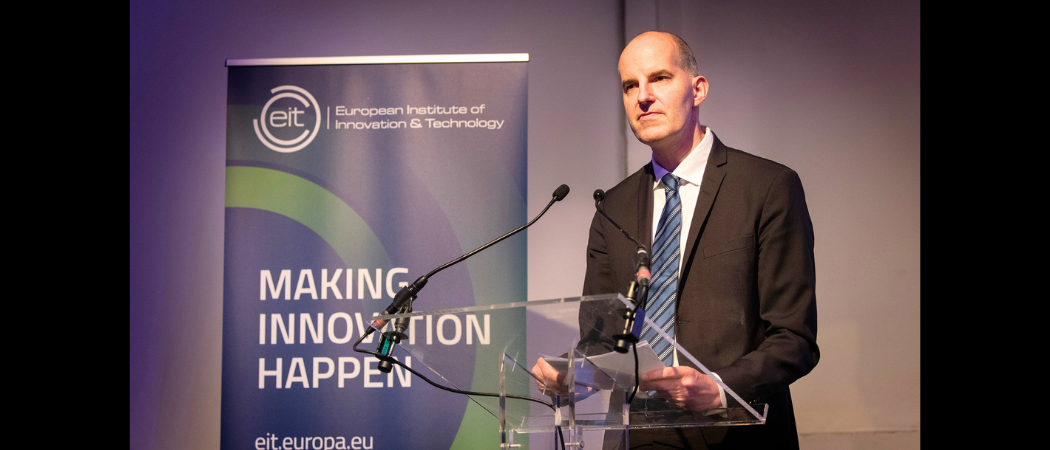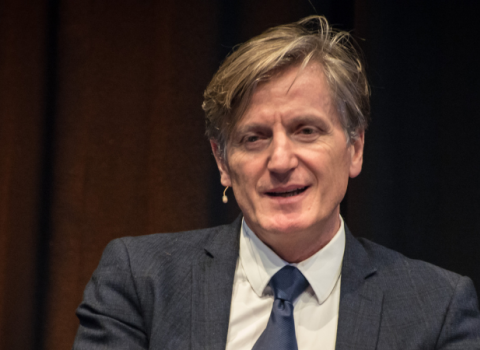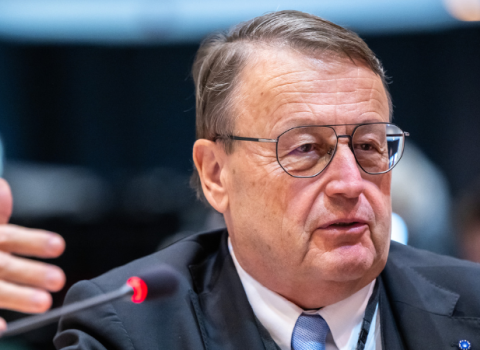The financial sustainability of the first EIT knowledge and innovation communities is proof the model works, says EIT director Martin Kern, after its future is called into question

EIT director Martin Kern speaking at the 2024 EIT Summit in Brussels this week. Photo: EIT / Flickr
The European Institute of Innovation & Technology (EIT) has developed a “very specific model” which is bearing fruit, its director Martin Kern told Science|Business after questions were raised about whether the organisation should continue in its current form under the next Framework Research programme, FP10, which is due to start in 2028.
EIT was launched in 2008, with the mission of bringing together organisations working in education, research and innovation across Europe.
It features nine knowledge and innovation communities (KICs) which tackle specific challenges. The main activities include entrepreneurship education, innovation-driven projects, and business creation services.
The KICs are meant to become financially independent of the EIT after 15 years. The first three KICs – EIT Climate-KIC, EIT InnoEnergy, and EIT Digital, set up in 2010 – have now achieved this according to Kern. Their EIT funding runs out at the end of this year, although discussions are underway about a possible extension.
“It’s a great thing for Europe that we created a system where partnerships themselves become sustainable,” Kern said in an interview whilst in Brussels at the EIT Summit on Tuesday. “The valuation of EIT InnoEnergy is close to €1 billion. Why would we not want to continue such a successful project?” he said.
The ability of the KICs to attract diverse sources of funding is even more reason to support the EIT model in a time of shrinking budgets, said Kern.
However, questions are now swirling about the rationale for EIT remaining separate from the European Innovation Council (EIC), launched in 2021 with the goal of helping start-ups attract the capital needed to scale. It is suggested EIC and EIT could be rolled under the same umbrella, and now, as attention turns to shaping FP10, a fresh debate is brewing.
The Danish government was first to put its cards on the table, arguing “the time has come to discontinue” EIT as a separate entity, in a position paper obtained by Science|Business.
“This is based on close consultation with stakeholders that find it increasingly difficult to identify added value and have chosen to opt out of this instrument,” the paper says.
The Danes say the education programmes run by the KICs are “clearly overlapping with Erasmus+”, and that there is overlap between some EIC and EIT projects. There should be a plan to “prepare the existing EIT-KICs for transforming into truly, financial sustainable, independent entities,” according to the position paper.
Kern said he was “a bit surprised” to learn of the merger proposal because the Danish government had not communicated its thoughts to the EIT. Yet, the paper has been circulating in the Brussels research and innovation bubble for several weeks.
Straws in the wind
At the annual Science|Business conference on 13 February, Portuguese MEP Maria da Graça Carvalho, a champion in the creation of EIT, said she defends both the EIC and EIT, but they “probably don’t need to be different two agencies”.
In response to this, Commission director general for research and innovation, Marc Lemaître, said “everything is on the table”.
The Commission is due to publish a mid-term evaluation of Horizon Europe, which encompasses both agencies, in the coming months.
“If there is something concrete proposed, of course, that's what midterm reviews are about,” said Kern. “But at this moment, it wouldn't be evident how you could bring back together these two programmes or agencies that have very different mandates and very different models.”
But the debate about where EIT is going is gathering momentum and at the EIT Summit, Normunds Popens, deputy director for education, youth, sport and culture at the European Commission, praised the EIC’s work, but admitted there will be questions about its future.
“It might seem logical that the EIT continues because of all these success stories, but the harsh reality is that there are always hard discussions on the EU budget,” he said.
Popens called on delegates to make an argument “for the EIT to stay as a separate instrument within the Horizon programme,” adding, the Commission must work with the EIT and stakeholders “to show that without the EIT this EU innovation ecosystem cannot continue.”
Financial sustainability
EIT points to the financial sustainability of the three first generation KICs as proof that its model works. Together, they had revenues of €135 million in the last three years.
This includes funding from the European Commission for EIT training programmes. The DG for Employment, Social Affairs and Inclusion supports the European Battery Alliance Academy, while the DG for the internal market, industry, entrepreneurship and SMEs is funding the European Solar Academy, which was launched on Tuesday.
“It feels a bit strange to have a discussion about should we stop that, because why would you change a winning team?” Kern said.
Each KIC has its own strategy. EIT InnoEnergy is first and foremost an investor in very early-stage start-ups, which it helps to accelerate.
“The model revolves around the fact that, once we've entered, at some point in time we exit and we recover the money, with an upside,” Baptiste Buet, director of the EU business unit at EIT InnoEnergy, told Science|Business.
EIT has fostered eight companies which went on to become unicorns, four of which were part of EIT InnoEnergy, including Northvolt, Europe's largest battery manufacturer, which last month secured a loan of $5 billion to expand production. Much of the KIC’s €1 billion valuation rests on the valuation of portfolio companies.
“We’ve built a portfolio of companies with equity positions in them, which is now valued at such a level that we have a runway in terms of exit to continue operations for a while,” said Buet.
EIT InnoEnergy was able to reach this stage thanks to the EIT grant and its wider ecosystem, Buet said. The grant has progressively reduced to a level where it is “an important component, but not a necessary component of our revenue model,” he said.
EIT Digital also has a portfolio of around 300 companies which it helped to create or scale, and in which it holds equity. It also helps companies looking for series A and B funding through its investors’ network, for which it receives a success fee.
In an interview with Science|Business last summer, EIT Digital CEO Federico Menna laid out his strategy for achieving financial sustainability by blending public and private activities.
This approach began in September 2022 and the first results now show it was the right strategy, Menna told Science|Business this week.
“We have become very well centred around the top priorities of Europe content-wise, but also the flagship initiatives,” he said. “We are now heavily involved in the Digital Europe programme, but also those initiatives that were deployed as part of the New European Innovation Agenda, namely the Regional Innovation Valleys.”
The ability to mobilise actors at a regional level is one of EIT Digital’s strengths. In the last year it has opened new offices in Greece and Romania, which are financed by the local ecosystems.
Menna also sees a “strong complementarity” between the EIT and EIC. “The EIC is focusing on the high-risk, high-return, high-investment part, which is needed in Europe, but all the rest is done by the EIT,” he said.
EIT launched its ninth KIC on culture and creativity in 2022 and a proposal for a new KIC on water is currently under review by the Commission, and others could follow.
“If we are approached by one of the other programmes to set one up, because there's a new political priority, EIT is totally ready to deliver on that,” Kern said. That will be dependent on the level of funding and the outcome of the FP10 negotiations.





 A unique international forum for public research organisations and companies to connect their external engagement with strategic interests around their R&D system.
A unique international forum for public research organisations and companies to connect their external engagement with strategic interests around their R&D system.